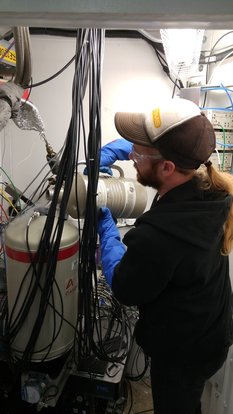 In the hutch at the beam line, adding liquid nitrogen to cool the fluorescence detector. In the hutch at the beam line, adding liquid nitrogen to cool the fluorescence detector. What is a soil scientist doing at a particle accelerator? For 4 days in mid-January I hunkered down in a cable-draped cubicle at the Stanford Synchrotron Radiation Lab (SSRL), bombarding my soil samples with X-rays. I’m not branching out into particle physics, but just wanted to learn information about how plant growth affects the chemical form of arsenic in my soils. Of course, I’m not working with just any plant, but with Pteris vittata, the brake fern with a special ability to hyperaccumulate arsenic. We are interested in how the fern accesses the arsenic in the soil, and whether this is different than what happens in the root zone of plants that don’t hyperaccumulate the toxic element. So, back to my original question: what am I doing at the particle accelerator? There are surely other ways to get information on plant-available arsenic, like various wet chemistry extractions. These can be really useful but run the risk of changing the chemical form during the procedure, and aren’t always very precise. Synchrotron radiation, on the other hand, can generate X-rays strong enough to allow us to look directly at our soils and “see” the molecular structure of the arsenic, with the soil sample still in a state similar to when it was in the ground at my field site surrounded by fern roots. Before going to the synchrotron for our beamtime, I had taken a really helpful short course on X-ray absorption spectroscopy, but still wasn’t really sure how the whole processed worked. Now, I’m still not totally sure, but I have a much better idea! Picture a ring the size of a small city block, with various buildings coming off at weird angles. In one of these buildings, an electron gun generates electrons, which speed up to almost the speed of light as they travel down a tube full of magnets (the linear accelerator!). Then, the electrons are injected into the ring, which is pretty large – it took me about 10 minutes to walk around it. As they spin around the ring, they have to be bent by magnets to stay in the ring. Every time they are bent, they lose energy as photons, little packets of light. These photons are the X-ray beam we shine on our samples. There are almost 30 total beamlines at SSRL, so many people can use the facility at one time to look at their samples. Some people are soil or environmental scientists looking at contaminants, like my group, some are materials scientists looking at nanoparticles and designing better batteries, some are biologists looking at proteins, and some are even art historians looking at how works of art were created. The beam is running 24 hrs a day, 7 days a week, so you can end up with a pretty interesting mix of people at the coffee machine in the wee hours of the morning!
0 Comments
|
AuthorSarick Matzen completed his PhD in Environmental Science, Policy, and Management department at University of California, Berkeley in 2020. He is now a postdoc in the Soil, Water, and Climate Department at the University of Minnesota working on iron cycling in marine systems. Archives
July 2019
Categories |
 RSS Feed
RSS Feed
